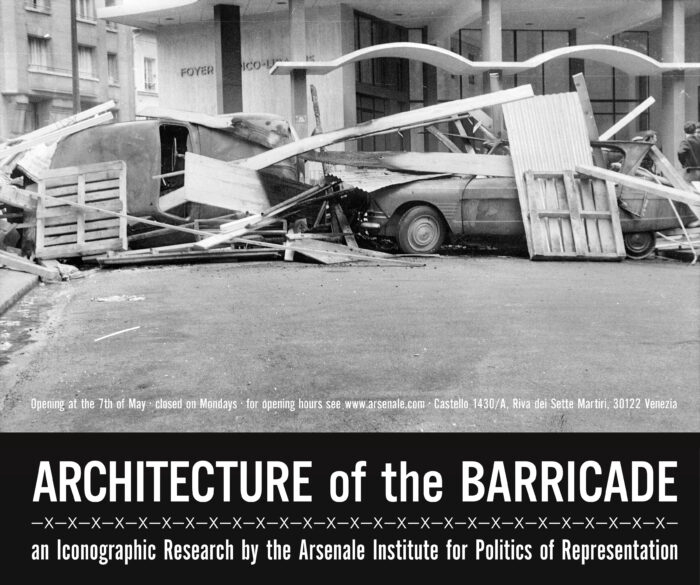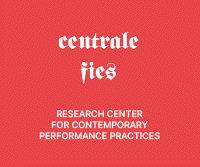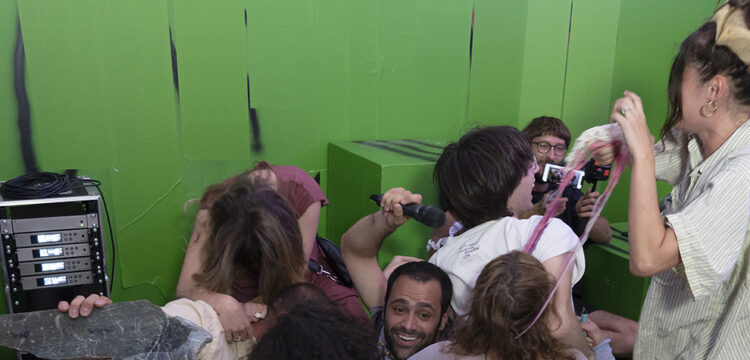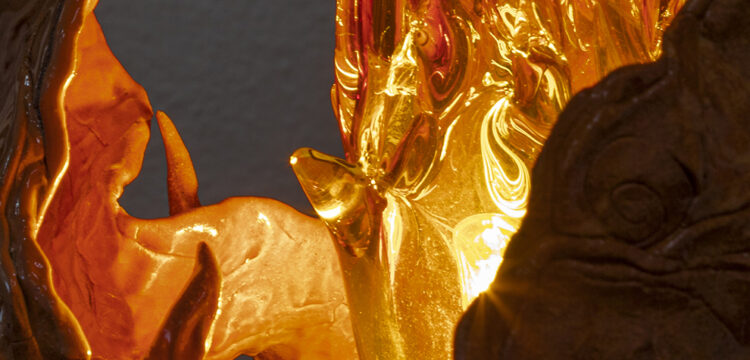Encampments in love
An Interview with GRU Collective
GRU is a group of affinity and study founded on the themes of territory, environment, and performing arts. Since 2021, it has been researching territorial contexts where the presence of water has triggered processes of social, cultural, and ecological transformation to be investigated and reworked through ever new and situated forms of relational and transdisciplinary art.
Carolina Feliziani: Let’s start from the beginning: When and how did GRU start? What is it about? What are its means of expression and the themes it addresses?
GRU: GRU has had multiple beginnings. Non-linearity is one of the string figure features of the collective! Let’s begin by saying that it started with an encounter: three friends who realized they had many areas of interest in common, and decided to converge around a shared journey and to continue traveling together. The group is composed by Margherita, curator and performer focused on contemporary live arts staged in non-conventional public spaces; Francesca B., a dancer from Trentino who collaborates with realities in her area that are engaged in social and artistic processes. She is also really passionate about botanical self-production; and Francesca N., a PhD candidate in ecocriticism whose research bridges literature and environmental issues. She also has a background in performing arts with a specific interest in the narrative potential of audio.
When we were younger, we were part of the same theater company in Bologna and during an artistic residency we discovered we were reading the same books! The Manifesto of Third Landscape by Gilles Clément and Junkspace by Rem Khoolas among these.
We started thinking at some core concepts together, to figure out how to integrate performance practices with narratives about environment and landscape, participatory projects and critical theory. A name came up: GRU. In its brevity, it seemed to perfectly encompass animal and mechanical transfiguration: the crane, the bird of the mythological dance, and the transformations in built urban spaces. It was 2019. As it often happens when one is still in a formation process, our paths parted. Each of us took different life trajectories that made us spatially apart from each other, while GRU continued to resonate as a collective call among nomad entities.
And that was up until 2021, when we decided to enroll together in the post Master’s degree program Environmental Humanities at the University of Roma Tre. The collective found its way thanks to this experience: creating a reservoir of shared practices and knowledge while having the opportunity to discuss and inform ourselves according to our interests.
Thanks to this shared experience, after modulating it according to the perspective and path of each of us, we began to elaborate our own artistic methodology, our own practice, holding together the multiplicity of our points of view. This educational experience made us more aware of our positionality, as well as of the issues we were interested to work on and of the theories and practices to look at.
We define ourselves as a techno-affective platform. We are able to build the more “technical” part listening, caring and sharing thoughts, while affectivity is an ongoing, feminist practice that we implement through self-discovery exercises, shared knowledge, mutual support, and dialogue.
With this modality, we work on the entangled thematic strings that emerge from our individual and collective paths. There are some topics we choose to develop together while keeping our individual peculiarities, three different styles that come from very different lives.
At the same time, we always try to adopt a multifocal gaze toward the territory we get in dialogue with.
We prefer to locate ourselves in a defined local dimension, to work in a specific context and to start relationships—as bodies, not only as researchers/performers/curators—with the people and inhabitants of the place. We first do exercises of active listening through informal relationship practices, so to get in touch with the places and the people.
We look for local biographies, storytelling, oral stories. Almost by chance, indeed, a privileged relationship with the element of water began: now we can say that it orients the vision of GRU to the contexts in which it operates; it’s the lens, the guide through which discover and “read” ecosystemic relationships. At least in this production phase. Water can tell a lot about places. It is a powerful metaphor, a polysemic symbol, but also a living matter, a physical element, a space, a resource, a form of energy. Through water we can trace historical-cultural-political processes that have modified spaces and territories over time. Attempting to summarize, we are interested in the relationship between narratives and territories. Donna Haraway, Marco Armiero, Stacy Alaimo, Franco La Cecla, Serenella Iovino, Isabelle Stengers, David Harvey, Federica Giardini produce the theory we look at. On a more concrete level, it is essential for us to plunge into the spatio-temporal contingency in which, from time to time, we find ourselves. Orality, collective writing, walking as a knowledge practice, relationships between bodies and spaces, and then again, the sound, the vocal performance are all tools and practices that are part of our journey and that, depending on the situation, we can reconfigure.
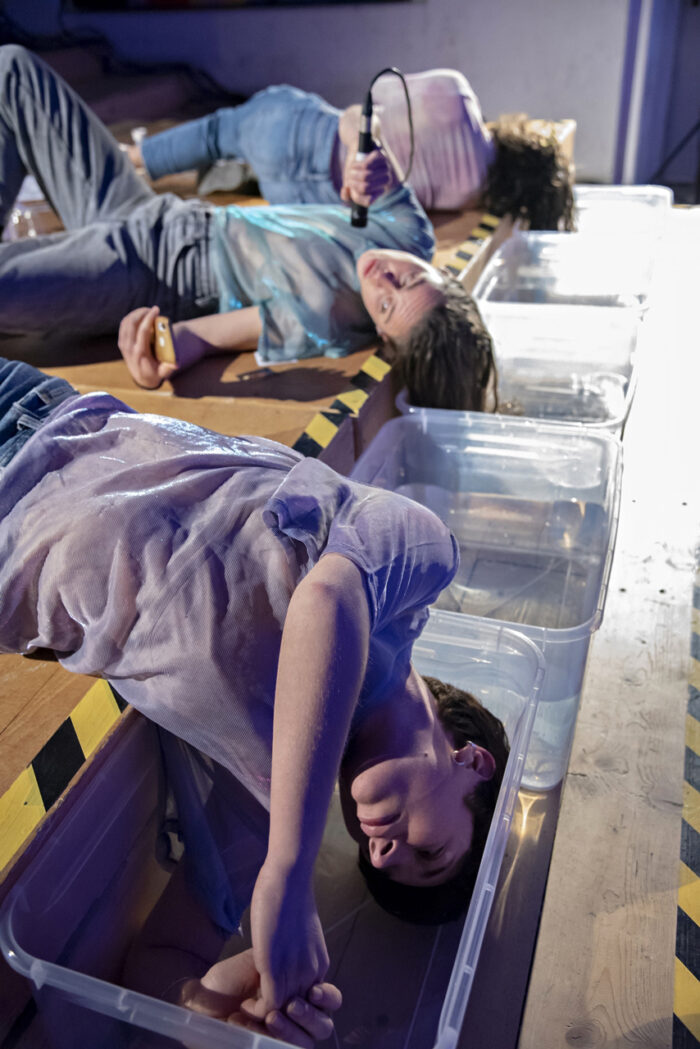
You define GRU as “a place to elaborate your personal space of confrontation”; how do you balance the personal, subjective dimension and the communal dimension that has to do with your work as a collective?
In this perspective, we use the image of the “weighbridge”; in all respects, the collective is an organism in an ongoing state of flux, and the balance is a constant reconfiguration of the relationships within the group, depending on the physical distances, the commitments, and the availability of each. In our group practice we start taking some time to ask each other how we feel, and the long time we spend on this is useful to reshape and tune each other out. There are times when one element of GRU is more involved and times when is less than the others, for personal reasons. And so, it is essential to redistribute things that need to be done. It’s difficult to maintain this deep listening and openness. Certainly, to let go and have these kinds of experiences together, trust, curiosity, and longing are essential. It’s a journey of mutual and personal knowledge. When needed, GRU truly is a support. Another practice we periodically master is to tell each other what we have done, learned, seen, studied in the period we have been parted, while the others, after listening, can re-tell, re-enact, embody what have heard from their own perspective. It’s always better to have multiple perspectives.
From a more practical standpoint, compared to working as a collective, say the technical part, GRU maintains at the same time this double collective and individual dimension, in the sense that each of us has great autonomy and in sharing discourse and expertise we do not always have the same roles. There are projects in which we are equally involved and others in which we are not. Eventually, periodically, we have moments of sharing and updating.
In general, it’s difficult to answer uniquely because we do not have a stability that shelters us from contingencies; so far, we accept this situation as constructively as possible. An example, however, may help to illustrate how each person’s life permeates the collective dimension. The last work we did was a performance in the open studio form, SUB-AQUA, that took place at Spazio Base in Milan last December. It all stemmed from a residency program that Fra B had the chance to participate in, with a personal project, however deeply rooted in GRU’s common themes. At some point during the residency it became clear to her that she needed to join GRU to share reflections and practice its methods to re-elaborate the work. The work was influenced by Fra N. recent doctoral studies about voice and orality. Study of voice, intertwining with the figure of the Siren, thus became a new branch of GRU’s research. Influenced by this, Margherita decided to resume her studies on vocal expression which she had left aside and was then selected for an advanced training course on contemporary vocality, “Malagola,” the school directed by Ermanna Montanari. This is to show how much individual research influences the collective and the collective influences individual choices, which are then reabsorbed by the collective and so on in a generative cycle.
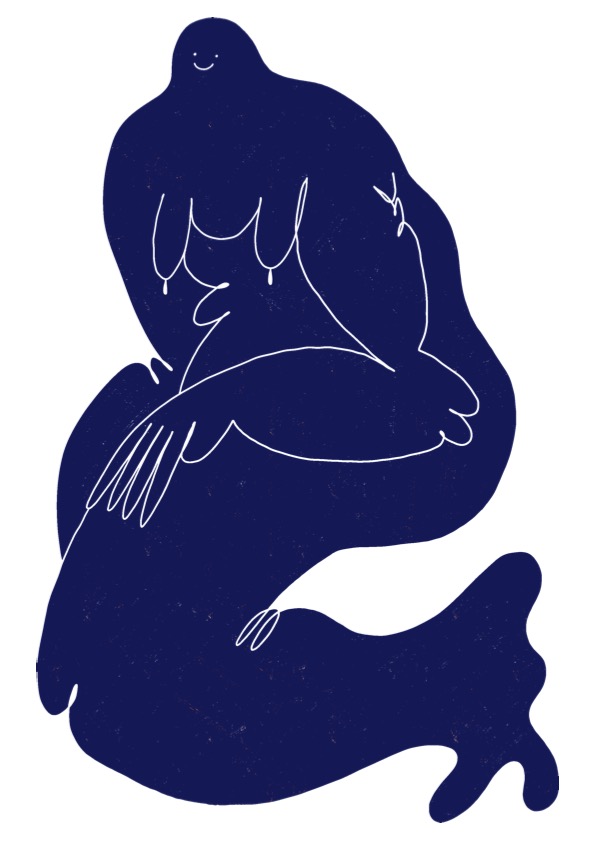
GRU’s research starts from the territory: lived, remembered, a territory that is part of the past and memory and that you attempt to push forward, into the future. How do you relate to the environments you inhabit and interpret? What is the connection you seek with the territories that traverse your artistic practice?
Starting with the concept of territory, we believe there is always a superstructure made by the narratives, the discourses that define it. In this sense, they are often “said,” “defined,” never “speaking.” Indeed, what we studied during the Master’s program—and Serena Olcuire’s reflection on marginality—was essential. Also, ecocriticism, the texts by Iovino, Armiero, Alaimo and, yet, de Certeau’s The Practice of Everyday Life and bell hooks’ thought, are fundamental so as not to forget how places and landscapes are texts continually re-shaped by the language and the narratives that define them and how they, in turn, create and react with the discursive material about them. This is undoubtedly an ineradicable dimension that needs to be known, read, interpreted and, often, counter narrated; however, for this decoding it is necessary to get in touch with the material, physical, ecosystemic elements of a place, there, where conflict emerges as a local manifestation of broader dynamics, and space returns a temporal stratification in a nonlinear form, a trace of the relations between humans and surrounding environments, social conflicts, invisibilized violence, silenced voices.
What we try to do is to return a complex, critical vision that can enhance the imagination between past, present, and future by being in relationship with the inhabitants, their bodies and biographies that become spokespersons of a territory. They express partial but subjective, embedded visions, that are like an intrinsic, experiential truth because they derive from people who inhabit the place. The one and the other dimensions—the discursive and the material—often contradictory, exist together, coexist, co-present in a territory but not exactly visible. In gathering this information, that are past histories, memories, expectations, future dreams, economic and ecological processes, anecdotes, desires, etc., we work creatively by making these levels interact by free association of ideas, horizontally, evocatively but without depoliticizing, instead, whenever possible, we try to explode and draw out the deep connections between seemingly very different phenomena. Art practice is precisely about making the different levels present, visible, and re-interwoven into creative forms that can both project the discourse onto a possible and alternative future imaginary, and retrace the link between micro and macro scale, re-inject the local into the larger dynamics in which we are all immersed.
This is our direction as a collective, then in praxis the difference between the three of us, as different subjectivities and bodies, with our own inclinations and sensibilities, is decisive. Sometimes, for some, the theoretical tools are preponderant, while at other times we allow ourselves to have a more mimetic relationship with the context and the environment that is central, co-protagonist, never a helpless background nor just an object of study. Being the three of us allows us to proceed by diffraction, maintaining and accepting the partiality, the contradictory nature, the multiplicity and, in a word, again, the complexity that exist of the real. For example, last September we were in Rovereto, in the neighborhood of Santa Maria, with “Diletta,” taking together a convivial walk with small installative stops that traced the connection between the neighborhood and the Leno stream that runs alongside the neighborhood. On that occasion, we were invited to the “Somenai” festival which was curated by both an association in the area that deals with slow journalism and a local art experimentation space, the Scuola di Sant’Osvaldo. Fra B. is originally from Rovereto and her grandmother was born and raised in that neighborhood, so we were guided by her, and the relationship of GRU as a collective with the territory, in that case, came through the experience and history of one of its members. Affections, friendships, personal backgrounds somehow became part of the warp that we generated.
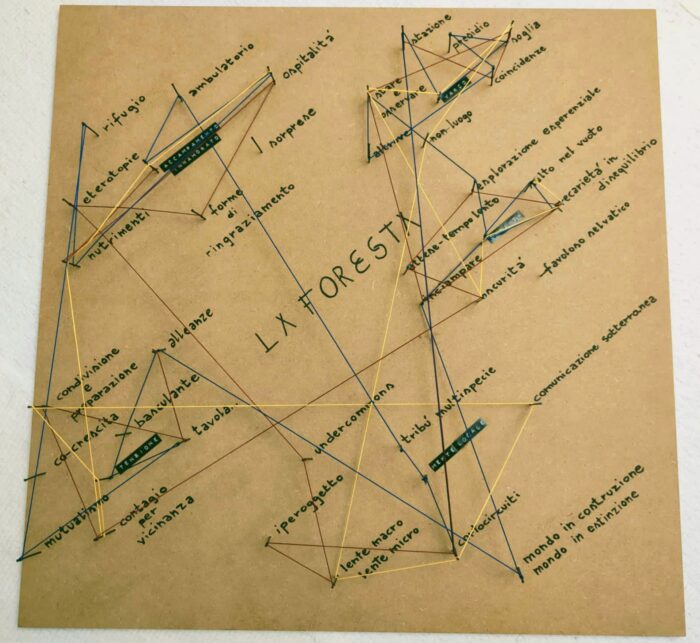
When you describe your language, you refer to three main mediums: poetry, performance, and sound. Are all three of these mediums part of the collective experience? Do you write together, perform together, produce sounds together? How does this collective creation happen in practice?
We designed a method to practice group-thinking while maintaining evidence of everyone’s subjective perspective. It is a tool abstract and material at the same time that allows us to sew us together, to choreograph a sort of entanglement, like a divination ritual around a common topic. We dedicate a long time to this practice during our project working sessions. It is, essentially, a sharing partiture of thoughts, feelings, readings, memories, gestures, and silence. We call this exercise “the making of the Labyrinth.” There are many references about an ancient ritual that evoked the crane-dance (geranos, in Greek) initiated by Theseus after defeating the Minotaur in the well-known labyrinth designed by Daedalus.
Although the exercise has a hint of performative act, it is a very intimate moment between us in which we spatially build our atlas of rational connections and symbolic constellations. We materially craft—with the help of strings, ropes, wood—this temporary geography of concepts and experiences, and then individually, each of us traces its own path on it.
Once we have created a common base, a texture of possible topics and directions, we start writing guided by some key words or key images: we write individually and then we share our written drafts reading aloud. Through connection, analogy, and discarding, we entangle our paths and writings together to search for those elements that are the most charged with potential. We compose an interweaving of the words, phrases, verses according to the performative needs and the context we are going to act in. Each of us has her own style but all the pieces gravitate around a common thought, and it is nice to be able to recognize each other in a dimension that exceeds singularity while maintaining its uniqueness. That’s because each of us has her own track to dance in order to get out of the labyrinth—assuming we can or want to do so.
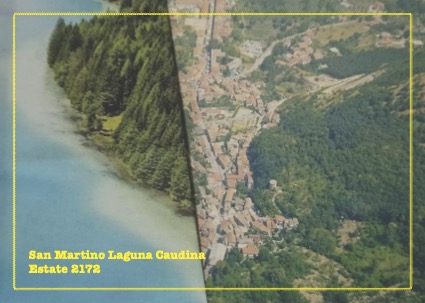
Designed by Tommaso Giordani
Let’s talk about one of your latest works, SUB-AQUA. What was it about? When and how did it take place?
According to the place, space, time and audience, we can change the artistic medium we choose and the staged performance. As mentioned, SUB-AQUA is a performance GRU presented in the form of a study at Spazio Base in Milan, last December, during Museo temporaneo delle Esperienze—the closing event of the project Più ~ Erbacce, an incubator for young artists who research in the field of performing arts.
During the residency, our main theoretical reference was the essay A piu voci, by feminist philosopher Adriana Cavarero. Starting from the mythological figure of the mermaid, the author traces the “submergence” of female voices and the sexualization of the female body throughout history. The Western philosophical thought has developed dualistic, simplifying and discriminatory epistemologies, and the mermaid, as a hybrid, is an inspiring figure that escapes the norm. We chose to place the mermaid at the center of our labyrinth, at the same time monster and victim, to reflect about the mermaids of our present.
Allowing ourselves to be led by the image of the hybrid mermaid, we made the water explode as a contradictory concept. Water is a fragile resource in the present socio-environmental crisis. In the language of advertising, water has often been associated with the idea of purity and with images of hyper-conforming, stripped and silenced, unreal, aestheticized, and sweetened female bodies. But at the same time, water has been used to submerge, cover and hide, reproducing a form of violence against those who threat the status-quo. As a natural element, a river, a lake or the sea, water streams have often been diverted by the human action in the wake of an extractive and utilitarian idea of progress, valuing, exploitation. Moreover, as we did in our previous works (San Martino Valle Caudina, Rovereto), we look for a local visual artist that could enter GRU’s world through the practice of graphic and drawing. In this case, we started to dialogue with an illustrator from Milan, Lineette, who came up with three different depictions of contemporary mermaids. SUB-AQUA has been an opportunity to bring the focal points of our artistic research to the surface—keeping the aquatic metaphor. In the final performance at Base, we traversed the multiple identities and meanings of water and we were able to give formal concreteness on stage to this singular-plural being of the collective, precisely through the medium of voice. On stage we were lying, like three contemporary mermaids, on a labyrinth of texts and images (hydrographic maps of the city, depictions of mermaids in various cultures and eras, novels, photos, posters and flyers on current events and on the struggle against 41-bis) to indicate the permeability between material and discursive dimensions. There we were, lying with our heads in the water, hair submerged and swaying, expressing sensuality and sensoriality—another element of the symbolic bearing of water—which we reclaim as women.
A microphone and a mobile phone in our hands: we all start reading a text-manifesto, a declaration written by a mermaid claiming her existence, her own space in the contemporary city. We were all moving our lips but the voice came out from only one mouth. For the audience the lip-sync effect has been of displacement and inability to recognize which of the three bodies the voice was really coming from: a chorus of mermaids that could somehow speak and give voice to many others.
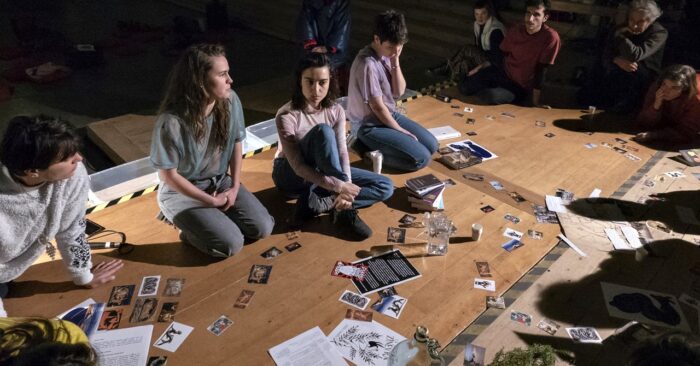
SUB-AQUA considered water as an integral part of the territory and as an element that can change it, influence it, shape its features and perception. Did the physical location in which you carried out this research work influence the outcome? How does water fit into your memories, into your past? Why is it a “lived” territory for you? And how have you “traversed” it?
In SUB-AQUA we had the chance to work on a concept without the reference of a specific physical territory. The process still developed from an intense exchange of emails, vocal messages and letters with inhabitants of the city of Milan. We chose to dialogue with the people who had a physical relationship with the space of the city, bodies that tell us different relationship, divergent from the mainstream narrative about the city. That influenced us a lot in our writings. In previous works we faced a precise aquatic referent: the Leno torrent in Rovereto, or the Caudino torrent in San Martino Valle Caudina, whereas this time we asked the people to tell us about their personal relationship with water, more in general, for instance, their first memories related to snow, water as a landscape element, water as a symbolic element in their personal lives. Water was not so much the subject but rather the vehicle to get to intimate stories. With a simple question like “Do you know where does the water you drink come from?” we can open spaces of discussion we would otherwise never have access to. Compared to our previous site-specific works, SUB-AQUA allowed us to work on a replicable model. In fact, we look forward to being able to replicate it somewhere else! Performing in a de-territorialized “white box” gave us some degree of abstraction. Although it was clear to us the connection with very well-defined local stories, the layering of embodied experiences, the text could speak to and about all places. The experience has been very important to us.
Future plans?
We are going to pursue our research on female aquatic roles and representations, crossing the different fields of academia, performing arts, and community-based projects. We choose to inhabit a hybrid transdisciplinary space because we want to work on the blurred margins of this tangent fields. We wish to find places suitable to host our next “encampments in love”—places where we can live together, think together, experiment together, to refine what is intended to be an adaptive spatial and relational practice. We are looking for spaces dedicated to artistic or academic research, without productive schemes, with an informal, non-hierarchical profile where true dialogue and exchange can take place. They exist! They are not chimeras! We have begun to cross-fertilize some dialogues that will take us to Rome and probably to Genoa, later this year. We will certainly return to places we have already been, like Caudina Valley Apennines, inner Campania, and in the alpine areas of Rovereto. Following the submerged trail of water, it will lead us there where the layered discourses about the water resource converge, to keep on working radically on future imaginaries.


